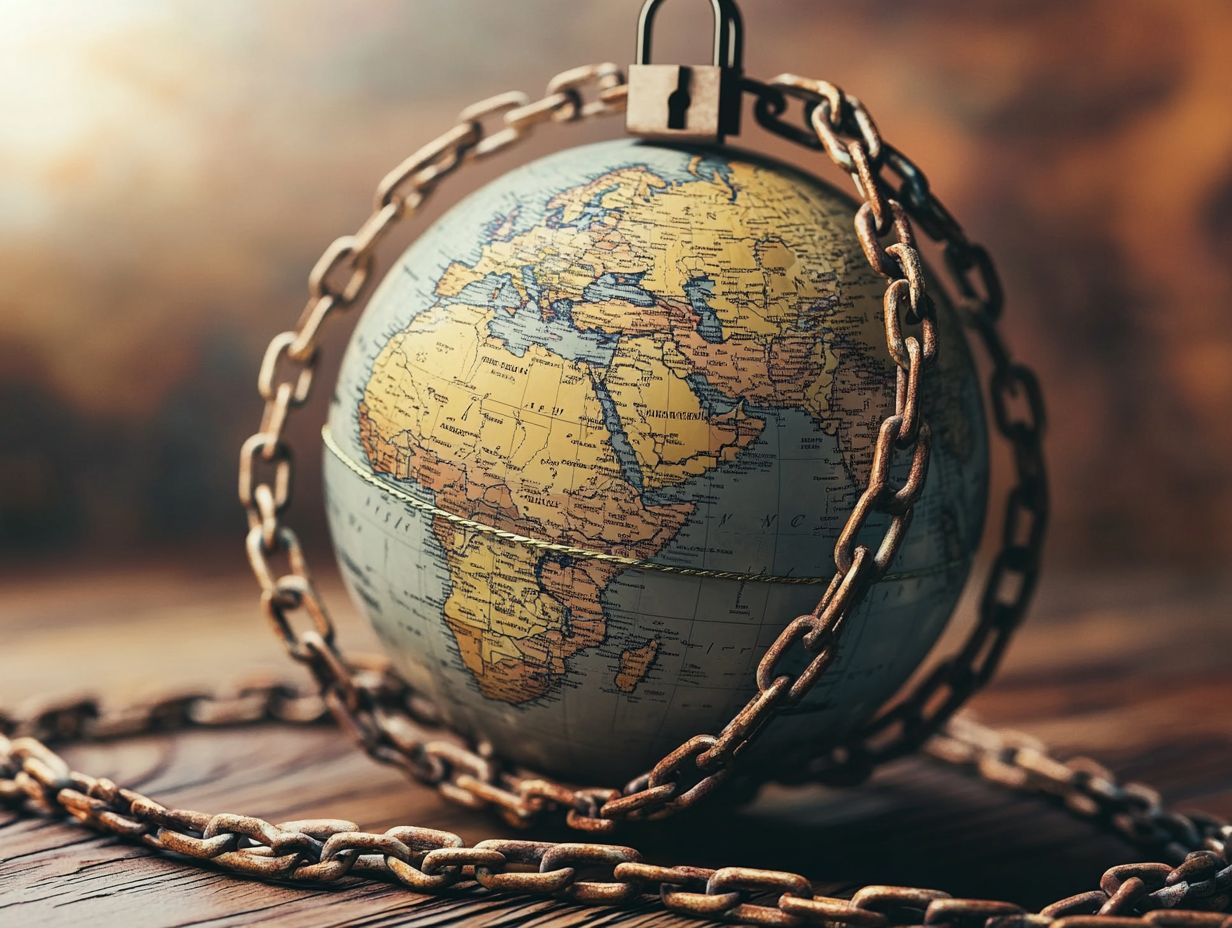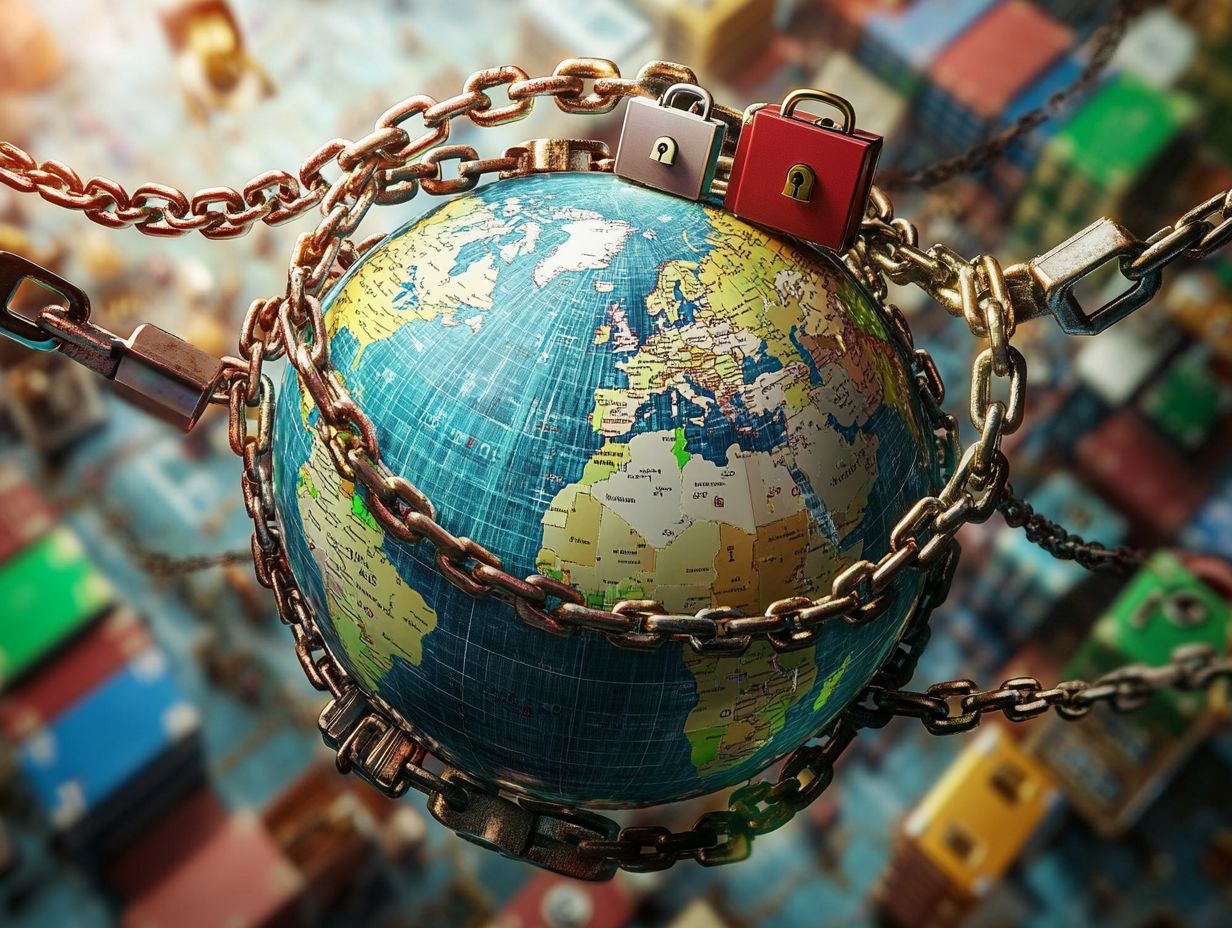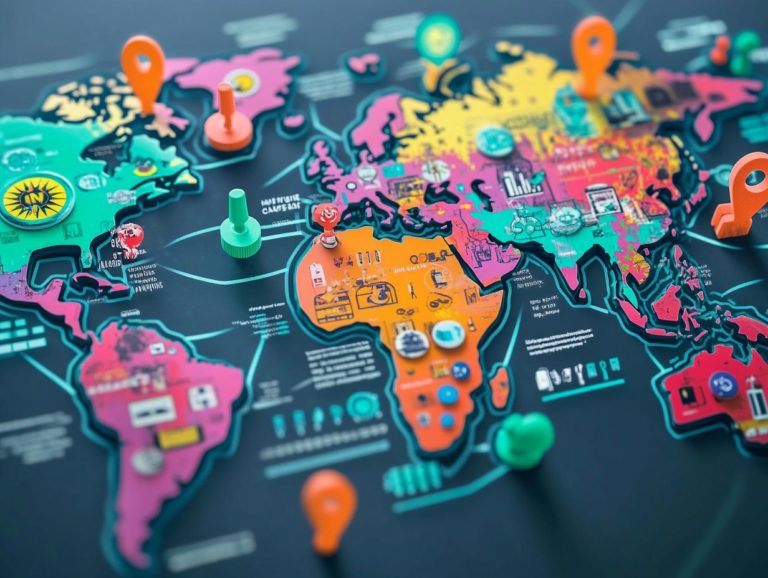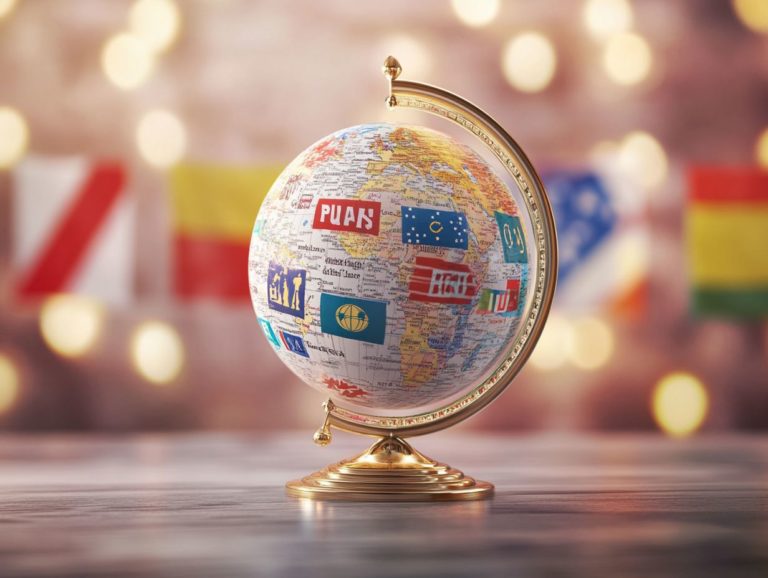Challenges in Protecting Trade Secrets Internationally
In today s global marketplace, protecting your trade secrets is crucial and complex.
Let s dive into the definition and significance of trade secrets, shedding light on the intricate challenges you face in safeguarding your ideas and inventions across international borders.
From the absence of uniform laws to differing cultural attitudes towards IP rights, you ll encounter multifaceted issues that require careful consideration.
We ll explore effective protection strategies, supported by real-world case studies that showcase both successes and setbacks.
As you navigate this intricate landscape, you ll gain insights into how to better guard your invaluable secrets in our interconnected world.
Contents
- Key Takeaways:
- Overview of Trade Secrets
- Challenges in Protecting Trade Secrets Internationally
- Strategies for Protecting Trade Secrets Internationally
- Case Studies and Lessons Learned
- Frequently Asked Questions
- What are trade secrets and why are they important to protect internationally?
- What are some common challenges in protecting trade secrets internationally?
- How can companies overcome language barriers when protecting trade secrets internationally?
- Are trade secrets protected in every country?
- How can companies ensure their trade secrets are adequately protected in international business transactions?
- What happens if a trade secret is leaked or stolen internationally?
Key Takeaways:
Lack of uniform laws and enforcement makes protecting trade secrets internationally challenging.
Identifying and proving misappropriation can be difficult when dealing with international trade secrets, as highlighted in the article on litigating trade secrets: challenges and strategies.
Understanding cultural differences and attitudes towards intellectual property is crucial in addressing the key challenges in international IP law today to protect trade secrets internationally.
Overview of Trade Secrets
Trade secrets are essential components of intellectual property, containing the confidential information and business practices that provide you with a competitive advantage in today s knowledge-driven economy.
To maintain the value of these secrets, it s crucial to implement reasonable protection measures, including effective employee training.
Your trade secret portfolio is among your most valuable assets. It demands careful safeguarding against both internal and external threats.
Definition and Importance
Trade secrets are confidential business insights that give you a competitive edge, including formulas, practices, and processes.
This information can range from a unique recipe in the food industry like Coca-Cola’s iconic formula to innovative manufacturing techniques that help a tech company reduce costs while enhancing quality.
By protecting these secrets, you secure your market position and refine your overall strategy, leading to a distinct edge in the marketplace.
In sectors like pharmaceuticals, trade secrets guard the confidentiality of drug formulations. In software, proprietary algorithms can set a company apart.
Effectively managing these assets ensures long-term profitability and fosters sustained innovation, highlighting their critical role in intellectual property rights.
Challenges in Protecting Trade Secrets Internationally
Protecting trade secrets globally poses challenges that can jeopardize your efforts to secure your intellectual property, making navigating international trade secrets law crucial for success.
You face a complex landscape marked by diverse legal frameworks and varying cultural perspectives on IP rights. As you navigate these waters, the risk of trade secret misappropriation increases, particularly with differing compliance measures and the threat of economic espionage.
Lack of Uniform Laws and Enforcement
The lack of uniform trade secret laws across jurisdictions complicates enforcing legal protections, leading to varied litigation risks for companies operating internationally in the context of trade secrets in the digital age.
This disarray creates confusion and increases the chances of inadvertent violations as you navigate a complex web of regulations.
The EU Trade Secrets Directive attempts to standardize some aspects of trade secret protection; however, discrepancies still exist that can impact your compliance obligations.
For example, a single innovation might be interpreted differently regarding protection across borders, complicating your safeguarding measures.
You may need to invest significant time and resources to adapt your strategies to align with these disparate legal frameworks, highlighting the urgent need for clearer harmonization in global trade secret laws.
Start safeguarding your trade secrets today to ensure your business thrives in this competitive landscape!
Difficulty in Identifying and Proving Misappropriation

One of the key challenges you face in protecting your trade secrets is the inherent difficulty in identifying and proving instances of misappropriation, which can stem from both internal and external threats. Understanding the future of trade secrets in a global economy can help navigate these complexities.
This complex landscape demands a comprehensive risk assessment that not only pinpoints potential vulnerabilities within your organization but also evaluates the motivations of competitors and disgruntled employees.
Gathering evidence for misappropriation claims can be daunting. It requires access to sensitive data and balances transparency with confidentiality.
The nature of business operations constantly evolves. This shift complicates what misappropriation means, impacting enforcement actions and potential legal consequences.
Cultural Differences and Attitudes towards Ideas and Creations
Cultural differences significantly shape attitudes toward ideas and creations, influencing your international collaborations and partnerships.
In regions where innovation is valued, organizations enforce strict protections for trade secrets. This is vital for maintaining a competitive edge.
On the other hand, in cultures that prioritize collaboration and knowledge sharing, the approach to safeguarding these secrets can be more lenient. This might lead to unexpected conflicts during joint ventures.
Additionally, varying compliance regulations across jurisdictions can add another layer of complexity. Some countries may demand strict adherence to rules and guidelines, while others may favor a more flexible approach.
Understanding these cultural nuances is crucial for your success. It ensures that you respect local customs while effectively protecting your invaluable intellectual assets.
Strategies for Protecting Trade Secrets Internationally
Protect your trade secrets effectively by adopting a comprehensive strategy that blends robust protection measures with international treaties and compliance protocols tailored to specific regulatory frameworks, as outlined in the trade secret protection process.
This multifaceted approach ensures that your valuable information remains secure, no matter where your business operates.
Utilizing International Treaties and Agreements
International treaties and agreements, such as the TRIPS Agreement (an international treaty on trade-related aspects of intellectual property) and the EU Trade Secrets Directive, are instrumental in establishing a robust legal framework for the protection of trade secrets.
These frameworks set minimum standards for safeguarding intellectual property, enabling you to operate within a globally recognized set of rules.
By aligning your internal policies with these treaties, you can enhance compliance with international regulations and significantly reduce the risks associated with intellectual property theft.
Moreover, you can leverage these treaties to bolster your legal position should disputes arise. Adhering to these international standards lends further legitimacy to your claims.
Consulting with legal experts who are well-versed in these agreements will allow you to identify specific strategies tailored to effectively protect your proprietary information.
Implementing Strong Internal Policies and Procedures
Developing and implementing robust internal policies and procedures is crucial for safeguarding your trade secrets from both internal and external threats.
You must prioritize comprehensive employee training initiatives that emphasize the importance of protecting sensitive information. Equip your team with the skills needed to recognize potential security breaches.
Establishing stringent access controls ensures that only authorized personnel can access confidential data. This effectively reduces the risk of accidental leaks or malicious activities.
Your confidentiality policies should be clearly defined and communicated, outlining employee responsibilities in handling sensitive information.
By fostering a culture of security awareness and accountability, you can significantly mitigate risks that could jeopardize your valuable trade secrets.
Collaborating with Local Counsel and Experts

Collaborating with local counsel and experts is an essential strategy for businesses navigating the complex landscape of protecting trade secrets in the age of remote work in international markets.
These partnerships offer insights into specific regulations. They help you understand cultural nuances that could impact operations.
Local counsel can conduct a detailed risk check, pinpointing potential vulnerabilities and compliance issues that you might not fully appreciate from afar.
Their expertise will guide you in crafting effective enforcement policies. This ensures that your strategies align not only with the legal framework but also with the unique characteristics of the jurisdiction.
By leveraging local knowledge, you can protect your trade secrets while establishing a strong defense against potential breaches.
Case Studies and Lessons Learned
Examining case studies of both successful and failed attempts at protecting trade secrets provides invaluable insights.
These experiences can shape best practices and set industry standards for effectively safeguarding intellectual property.
Examples of Successful and Failed Attempts at Protecting Trade Secrets Internationally
Numerous examples demonstrate both successful and failed attempts at safeguarding trade secrets globally, highlighting the complex landscape of trade secret laws and the associated litigation risks. Understanding how to protect your trade secrets is crucial in navigating this environment.
Take the United States, for instance. The case of DuPont vs. Chris Williams showcases a strong enforcement policy that effectively protected proprietary chemical formulas, acting as a powerful deterrent against future violations.
On the other hand, a global technology firm faced significant challenges when mismanaging its trade secrets, leading to leaks and costly legal battles. This situation highlights the need for essential tools for protecting trade secrets and illustrates vulnerabilities in enforcement strategies.
This contrast highlights the necessity of stringent legal protections along with comprehensive training and internal policies to mitigate risks.
Explore these case studies to gain powerful insights into the effectiveness of various enforcement mechanisms for protecting intellectual property across different jurisdictions.
Frequently Asked Questions
What are trade secrets and why are they important to protect internationally?
Trade secrets are valuable and confidential information, such as formulas, designs, or processes, that give a company a competitive advantage. Protecting them internationally is essential for maintaining a competitive edge and preventing competitors from accessing sensitive information.
What are some common challenges in protecting trade secrets internationally?

Common challenges include navigating different legal systems and cultural norms, language barriers, and varying levels of intellectual property law enforcement. Countries have different definitions and criteria for what qualifies as a trade secret, complicating the establishment of international protection standards.
How can companies overcome language barriers when protecting trade secrets internationally?
Companies can overcome language barriers by collaborating with local legal counsel fluent in the local language. This ensures that all documents and agreements related to trade secrets are accurately translated and understood.
Are trade secrets protected in every country?
No, trade secret protection laws vary by country. Some countries may not recognize trade secrets as a form of intellectual property, while others have weaker enforcement mechanisms. Companies must research the laws and regulations of each country they operate in or plan to expand into for adequate protection of their trade secrets.
How can companies ensure their trade secrets are adequately protected in international business transactions?
Companies can protect their trade secrets by including non-disclosure and confidentiality clauses in contracts. They should also carefully check potential partners and employees to ensure they can be trusted with sensitive information.
What happens if a trade secret is leaked or stolen internationally?
If a trade secret is leaked or stolen, companies can take legal action to protect their rights. Seeking compensation for damages can be costly and complicated, so it’s essential for companies to have strong measures in place to prevent such incidents.







